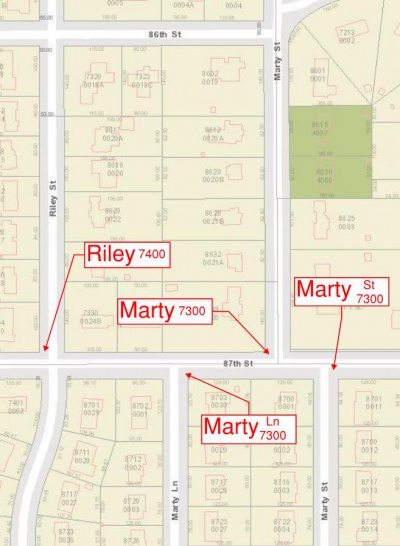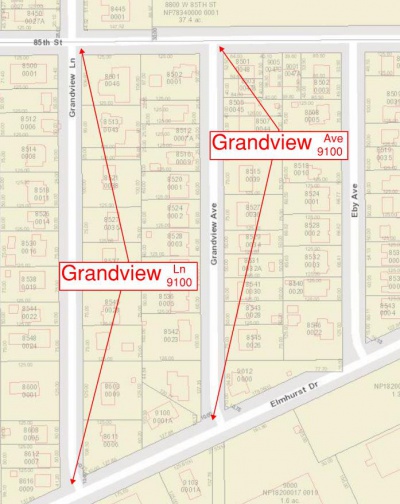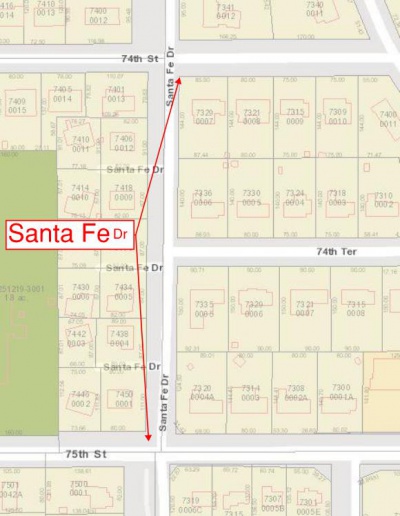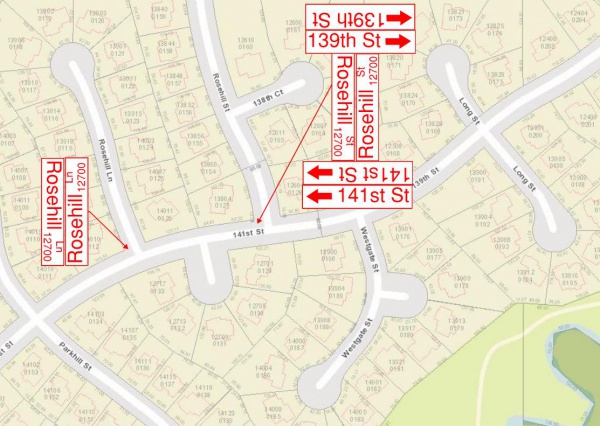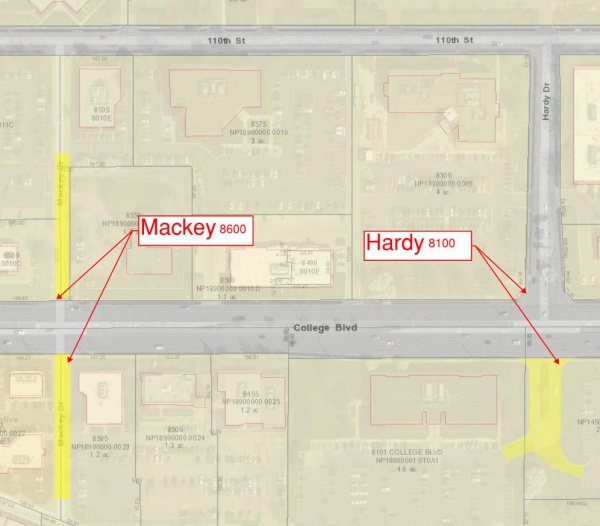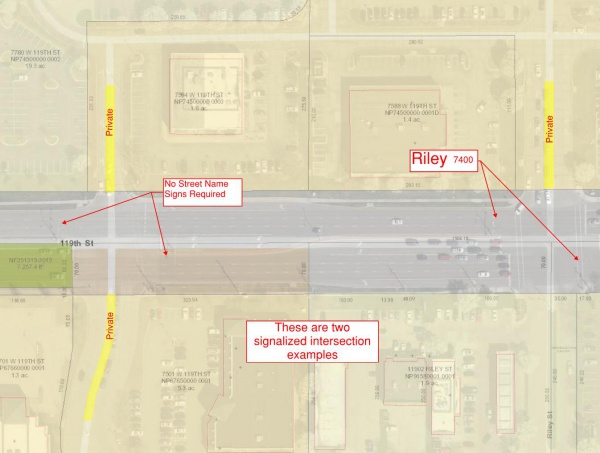Street Name Sign Design Guidelines
City Guidelines Regarding the Installation of “Street Name” (D3-1) Signs
Traffic Services Division of the Department of Public Works
Last Revised 4/6/16
Governing Document Reference:
Manual on Uniform Traffic Control Devices for Streets and Highways (MUTCD), 2009 or latest edition and the Overland Park Municipal Code (OPMC), Title 12 – Traffic, Chapter 12.04.
MUTCD Requirements:
“Street Name” (D3-1) signs should be installed in urban areas at all street intersections regardless of other route signs that might be present and should be installed in rural areas to identify important roads that are not otherwise signed.
In business or commercial areas and on principal arterials, “Street Name” (D3-1) signs should be placed at least on diagonally opposite corners. In residential areas, at least one “Street Name” (D3-1) sign should be mounted at each intersection. Signs naming both streets should be installed at each intersection. They should be mounted with their faces parallel to the streets they name.
To optimize visibility, “Street Name” (D3-1) signs may be mounted overhead. “Street Name” (D3-1) signs may also be placed above a regulatory or “Stop” or “Yield” sign with no required vertical separation. At intersection crossroads where the same road has two different street names for each direction of travel, both street names may be displayed on the same sign along with directional arrows.
City of Overland Park Guidelines for Installation:
Introduction:
The following guidelines have been established to assist with continuity throughout the city when fabricating and installing street name signs.
Referrals:
Questions regarding this document can be referred to:
Aaron DuBois, Planner I (895-6197)
Therese Lyons, Development Coordinator (895-6237)
Mike Nelson, GIS Analyst (895-6213)
Bruce Wacker, Assistant City Traffic Engineer (895-6027)
The following two tables are the Standard List of Abbreviations for street name sign legends in the City of Overland Park:
Abbreviations For Street Name Designations
| Designation | Abbreviation | Designation | Abbreviation |
| Avenue | Ave | Parkway | Pkwy |
| Boulevard | Blvd | Place | Pl |
| Circle | Cir | Plaza | Plz |
| Court | Ct | Road | Rd |
| Creek | Cr | Street | St |
| Drive | Dr | Terrace | Ter |
| Highway | Hwy | Trail | Tr |
| Lane | Ln | Way | Way |
Abbreviations For Numerical Designations
| Designation | Abbreviation |
| First | st |
| Second | nd |
| Third | rd |
| Fourth to Ninth | th |
Street Suffixes:
Thoroughfare Streets
- Include suffixes such as “Rd”, “Blvd” and “Ave”, unless the suffix is “St”, in which case the “St” should be omitted.
- Example where the suffix would be included:
- “Mission Rd”, “Roe Ave”, “Nall Ave”, “Metcalf Ave”, “Antioch Rd”, “Switzer Rd”, “Quivira Rd”, “Pflumm Rd” or “Lackman Rd” are all correct.
- Include the suffixes such as “Rd”, “Blvd”, “Pkwy”, “Dr”, “Cir”, “Ln”, “Ave” on all the streets listed in Appendix B, except for the suffix “St” which should be omitted.
- Example where the suffix would be included:
- “Shawnee Mission Pkwy”, “Johnson Dr” or “College Blvd” are all correct.
Collector Streets
- Generally omit suffixes such as “Rd”, “Ave” and “St”, unless it is listed on Appendix B where the street name is the same name as a nearby city which could be confused as a destination rather than a street.
- Example where the suffix would be omitted:
- “Lamar”, “Lowell”, “Grant”, “Nieman” and “Rosehill” are correct.
- Include the “St” suffix on any street name sign when there is an adjacent parallel street in the same block that has the same street name but a different suffix.
- Include the suffixes such as “Rd”, “Blvd”, “Pkwy” on all the streets listed in Appendix B, except for the suffix “St” which should be omitted.
- Example where the suffix would be included:
- “Somerset Dr”, “Tomahawk Creek Pkwy” or “Indian Creek Pkwy” are all correct.
Residential Streets
- Omit the “St” suffix on any street name sign except when there is an adjacent parallel street that has the same street name but a different suffix.
- Example where the “St” suffix would be omitted
- “Riley” and not “Riley St” is correct between 87th St and 89th St (See below).
- “Marty” and not “Marty St” is correct north of 87th Street (See below).
- Example where the “St” suffix would be included
- “Marty St” and “Marty Ln” are correct between 87th St and 89th St (See above).
- Include the “St” suffix if the street name is the same name as a nearby city which could be confused as a destination rather than a street.
- Example where the suffix would be included:
- “Fairway St”, “Shawnee Dr” or “Overland Park Dr” are correct.
- Omit any other suffix on any street name sign unless there is an adjacent parallel street that has the same street name but a different suffix.
- Example where the suffix would be omitted:
- The suffix “Ln” and “St” would both be omitted from “Grant”, on each side of 79th Street, because they are not parallel streets within the same block (See below).
- Example where the suffix would be included:
- It is appropriate to include the suffix for “Grandview Ln” and “Grandview Ave” between 85th St and Elmhurst Dr because they are parallel streets within the same block. (See below).
- Include the suffixes such as “Rd”, “Blvd”, “Pkwy” on all the streets listed in Appendix B, except for the suffix “St” which should be omitted unless there is a parallel street with the same name.
- Example where the suffix would be included:
- “Elmhurst Dr” or “Three Lakes Pkwy” are correct.
Hundred Blocks:
- Do not put hundred blocks on East-West streets.
- Example:
- “College Blvd”, “Johnson Drive”, “Shawnee Mission Pkwy”
- Do not put hundred blocks on any street that is listed in Appendix B, even though a section may run true north and south.
- Example where the hundred block would be omitted:
- "Santa Fe Dr” without the hundred block would be correct. (See Below)
- Do not put hundred blocks on streets that run diagonal through the city if they cross other streets with established hundred blocks.
- Example:
- “Santa Fe Dr” between 87th Street and 79th Street
- “Elmhurst Dr” between England and Antioch Rd
- Exceptions to the hundred blocks do occur where the normal sequence of numbering is juxtaposed. A quick review of the actual hundred blocks that actually exist should be reviewed prior to automatically associating the standard hundred block with the standard street name. Some examples of this are as follows:
- Monrovia is generally the 12100 block except between 103rd St and 105th St where it becomes the 12300 block
- Caenen is generally the 12200 block except between 103rd St and 105th St where it becomes the 12400 block
- Oakmont is generally the 12300 block except between 103rd St and 105th St where it becomes the 12500 block
- Century is generally the 12400 block except between 103rd St and 105th St where it becomes the 12560 block
- Long is generally the 12500 block except between 103rd St and 105th St where it becomes the 12600 block
- The hundred blocks in Appendix C can be used, even if they occur along with a street name from Appendix A with the same hundred block. You could be driving along an east-west street and encounter a street name sign Palace 7300 and then another street name sign Marty 7300.
Directional Arrows:
- Directional arrows should be used to identify where the street name changes from one name to another name.
- Example: (See Below)
- Intersection of Rosehill St and 139th St / 141st St
- “139th St” would have an arrow pointing to the east
- “141st St” would have an arrow pointing to the west
- “Rosehill St” would be the appropriate sign at this intersection
- “Rosehill Ln” would be the appropriate sign at 141st St and Rosehill Ln
- Directional arrows should not be used to differentiate a public street from a private street. As long as the side street has at least one leg that is a platted street, the private leg would be considered to have the same name.
- Example 1: (See Below)
- Intersection of Mackey and College Blvd
- Mackey is a private street north and south of College Blvd. The north leg of Mackey is a platted street with a name that fits our standard street name grid. College Blvd is also wide enough such that street name signs are required on both sides of the street. The street name sign should be “Mackey 8600” with no directional arrows. The sign would be installed on each side of College Blvd.
- Example 2: (See Above)
- Intersection of Hardy and College Blvd
- Hardy is a private street south of College Blvd and a public street north of College Blvd. Hardy is a platted street on the north side with a name that fits our standard street name grid. College Blvd is also wide enough such that street name signs are required on both sides of the street. The street name sign should be “Hardy 8100” with no directional arrows. The sign would be installed on each side of College Blvd.
- Where both legs of a side street are private and are not platted as a named street according to the standard street name grid, street name signs will not be installed at all.
- Example 1: (See Below)
- Intersection of 119th Street and the access drive west of Riley
- This is an intersection with private streets north and south of 119th Street. Neither of the side street legs are a platted street with a name that fits our standard street name grid. No street name sign is installed at this intersection.
- Example 2: (See Above)
- Intersection of 119th Street and Riley
- Riley is a platted street on the south side with a name that fits our standard street name grid. The north leg is a private street. This intersection is signalized so it has an overhead street name sign. The street name sign should be “Riley 7400” with no directional arrows. The current sign does have an arrow to the south. When this sign needs to be replaced, it would not require the arrow.
Overhead Street Name Signs:
General Guidelines:
The Street Name sign will consist of the name of the street, the street suffix and the block number as outlined in the above guidelines.
The size of the standard aluminum sign blank shall be 18” high by 60”, 72”, 84" or greater in 6" increments depending on the length of the legend. In some cases, sign blanks ranging from 96” to 120” or longer will have to be used to accommodate longer street names. The lettering style shall conform to Highway Series E-modified 2000 uppercase and lowercase lettering with 100% recommended letter spacing according to the Standard Highway Sign Manual. Where the sign length is too long to fit on the mast arm, the sign length will be adjusted accordingly by reducing the word spacing, letter spacing, etc as required. Each sign that needs to be adjusted will be reviewed by the engineer prior to final plans or fabrication. The letter height of the street name shall be 8” for uppercase and 6” for lowercase. The letter height of the street designation shall be 5” for uppercase and 3 ¾” for lowercase. The letter height for the block number shall also be 5”. The letter height of the numeral extension such as “th” in “127th” shall also be 6” high lowercase.
The street designation and the block number should be located at the right hand side of the blank and centered above each other as indicated in the standard details. If there is not a street designation, the block number should be centered vertically in the sign blank. Any arrow designations should be centered vertically in the sign blank and be 7 ½” high by 9 ½” long.
Refer to the City of Overland Park Overhead Street Name Sign Standard Details for guidance in sign layout.
Practical Guidelines and Sign Samples for Overhead Mounted Street Name Signs:
There are practical guidelines that should be observed during the design or fabrication of street name signs. If a sign legend is such that the design length of the sign is slightly longer than the next smallest sign blank, judgment may be exercised with letter spacing to achieve the most cost effective solution. In specific instances, the sign length may have to be reduced due to physical limitations, i.e. so it fits between signal heads on the mast arm. The following samples are presented in order to assist the designer or fabricator in selecting the correct length of sign blank.
| Overhead Street Name Signs | ||
|---|---|---|
| Street Name | Hundred Block | Letter Series |
| 123 Overhead SNS Template | Series Emod 2000 | |
| Series Emod 2000 | ||
| Series Emod 2000 | ||
| Series Emod 2000 | ||
| Series Emod 2000 | ||
| Series Emod 2000 | ||
| Series Emod 2000 | ||
| Series Emod 2000 | ||
| Series Emod 2000 | ||
| Series Emod 2000 | ||
| Series Emod 2000 | ||
Locations of Overhead Street Name Signs:
Overhead Street Name signs will be installed on the mast arms of traffic signals. The Overhead Street Name sign will generally be installed between the vertical pole shaft and the first traffic signal head and centered as much as possible on the lane.
Overhead Street Name signs will not be installed at locations designating private commercial drive entrances nor private streets. They also will not be installed for interstate ramp designations at interchanges with thoroughfare streets.
Streets with Multiple Names:
At intersection crossroads where the same road has two different street names for each direction of travel, both street names should be shown on the same sign along with directional arrows. The street name with the left arrow should be placed on top of the street name with the right arrow. The sign height should be increased to 24”.
Post-Mounted Street Name Signs:
The Street Name sign will consist of the name of the street, the designation of the street and where physically practical, the block number. It is understood that certain situations preclude the installation of the block number. These situations are not listed specifically, but will be addressed as the specific circumstances arise. It is the general intent that whenever possible, the block numbers should be included on the Street Name sign.
The standard sized aluminum sign blanks shall be 12” high by 24”, 30”, 36", 42" or 48” in length depending on the length of the legend. The standard lettering style shall conform to Highway Series C 2000 with a leading uppercase letter and trailing lowercase letters with 100% recommended letter spacing according to the Standard Highway Sign Manual. To accommodate longer street names in extreme cases, Highway Series B 2000 letters will have to be used to avoid exceeding a 48” long sign blank. In no case will the sign length be longer than 48”. Where the sign length is too long to fit on a 48" blank with Highway Series B 2000 letters, the letter spacing can be reduced from 100% as necessary. The letter height of the uppercase letter in the street name shall be 6”. The lowercase letters in the street name shall be 4 ½”. The uppercase letter height of the street designation and the block number shall be 3”. The lowercase letter height of the street designation shall be 2 ¼”. The letter height of the numeral extension such as “th” in “127th” shall also be 3” high composed of all lowercase letters. A minimum of 1 ¼” spacing is required between the edge of the sign blank and the edge of the first and last letter in the legend.
The street designation and the block number should be located at the right hand side of the blank and centered above each other as indicated in the standard details. If there is not a street designation, the block number should be centered vertically in the sign blank. Any arrow designations should be centered vertically in the sign blank and be 3” high by 4” long.
Refer to the City of Overland Park Street Name Sign Standard Details for guidance in sign layout.
Practical Guidelines and Sign Samples for Post-Mounted Street Name Signs:
There are practical guidelines that should be observed during the design or fabrication of street name signs. If a sign legend is such that the design length of the sign is slightly longer than the next smallest sign blank, judgment may be exercised with letter spacing to achieve the most cost effective solution. The following samples are presented in order to assist the designer or fabricator in selecting the correct length of sign blank.
| Post-Mounted Street Name Signs | ||
|---|---|---|
| Street Name | Hundred Block | Letter Series |
| Typical Numbered Streets | NA | Series C 2000 |
| Aberdeen | 3000 | Series C 2000 |
| Acuff | 14500 | Series C 2000 |
| Albervan | 14200 | Series C 2000 |
| Alden | 14800 | Series C 2000 |
| Alhambra | 4000 | Series C 2000 |
| Antioch Rd | 8700 | Series C 2000 |
| Ash | 5300 | Series C 2000 |
| Ash Dr | 5300 | Series C 2000 |
| [[media:|Ballentine]] | 10800 | Series X 2000 |
| Barkley | 6800 | Series C 2000 |
| Barton | 11200 | Series C 2000 |
| Belinder | 2700 | Series C 2000 |
| Benson | 8900 | Series C 2000 |
| Beverly | 6100 | Series C 2000 |
| Beverly Ct | NA | Series C 2000 |
| Beverly Dr | 6100 | Series C 2000 |
| Birch | 5400 | Series C 2000 |
| [[media:|Bluejacket]] | 10900 | Series X 2000 |
| [[media:|Bluejacket Dr]] | 10900 | Series X 2000 |
| Bond | 11500 | Series C 2000 |
| [[media:|Bradshaw]] | 12900 | Series X 2000 |
| Briar | 5000 | Series C 2000 |
| [[media:|Broadmoor]] | 6900 | Series X 2000 |
| Buena Vista | 4100 | Series C 2000 |
| Caenen | 12200 | Series C 2000 |
| [[media:|Cambridge]] | 2000 | Series X 2000 |
| [[media:|Canterbury]] | 3200 | Series X 2000 |
| Carter | 9600 | Series C 2000 |
| Catilina | 4200 | Series C 2000 |
| Cedar | 4900 | Series C 2000 |
| Century | 12400 | Series C 2000 |
| [[media:|Chadwick]] | 3100 | Series X 2000 |
| Cody | 11700 | Series C 2000 |
| College Blvd | 11100 | Series C 2000 |
| Connell | 9800 | Series C 2000 |
| Conser | 7600 | Series C 2000 |
| [[media:|Constance]] | 15000 | Series X 2000 |
| [[media:|Cottonwood]] | 14000 | Series X 2000 |
| Craig | 8000 | Series C 2000 |
| Darnell | 14900 | Series C 2000 |
| Dearborn | 6000 | Series C 2000 |
| Delmar | 4300 | Series C 2000 |
| [[media:|Earnshaw]] | 12000 | Series C 2000 |
| Eaton | 2100 | Series C 2000 |
| Eby | 9000 | Series C 2000 |
| El Monte | 4400 | Series C 2000 |
| England | 9300 | Series C 2000 |
| Fairway | 2900 | Series C 2000 |
| [[media:|Falmouth]] | 3300 | Series C 2000 |
| Farley | 9900 | Series C 2000 |
| Flint | 11400 | Series C 2000 |
| Floyd | 7200 | Series C 2000 |
| Fontana | 4500 | Series C 2000 |
| Foster | 7500 | Series C 2000 |
| Garnett | 11800 | Series C 2000 |
| Gillette | 13000 | Series C 2000 |
| Glenwood | 6700 | Series C 2000 |
| Glenwood Ave | 6700 | Series C 2000 |
| Goddard | 10700 | Series C 2000 |
| Goodman | 8200 | Series C 2000 |
| Granada | 4600 | Series C 2000 |
| Grandview | 9100 | Series C 2000 |
| Grandview Dr | 9100 | Series C 2000 |
| Grant | 9500 | Series C 2000 |
| Greenwood | 14400 | Series B 2000 |
| Hadley | 8400 | Series C 2000 |
| Hallet | 14100 | Series C 2000 |
| Happy Hallow Dr | 12400 | Series B 2000 |
| Hardy | 8100 | Series C 2000 |
| Haskins | 13400 | Series C 2000 |
| Hauser | 13300 | Series C 2000 |
| Hayes | 9400 | Series C 2000 |
| Hemlock | 8300 | Series C 2000 |
| High | 2400 | Series C 2000 |
| Horton | 6200 | Series C 2000 |
| Horton Ct | 6200 | Series C 2000 |
| Horton Ln | 6200 | Series C 2000 |
| Howe | 3800 | Series C 2000 |
| Johnson Dr | 5900 | Series C 2000 |
| Juniper | 5100 | Series C 2000 |
| Kenneth Rd | 2300 | Series C 2000 |
| Kessler | 9200 | Series C 2000 |
| King | 11300 | Series C 2000 |
| Knox | 9700 | Series C 2000 |
| Lackman Rd | 15100 | Series C 2000 |
| Lamar Ave | 6300 | Series C 2000 |
| Larsen | 10600 | Series C 2000 |
| Linden | 4800 | Series C 2000 |
| Long | 12500 | Series C 2000 |
| Lowell Ave | 7900 | Series C 2000 |
| Lucille | 11600 | Series C 2000 |
| Mackey | 8600 | Series C 2000 |
| Manor | 2600 | Series C 2000 |
| Maple | 5600 | Series C 2000 |
| Maple Ct | 5600 | Series C 2000 |
| Marty | 7300 | Series C 2000 |
| Mastin | 10100 | Series C 2000 |
| Meadow | 2500 | Series C 2000 |
| Melrose | 10500 | Series C 2000 |
| Metcalf Ave | 7100 | Series C 2000 |
| Mission Rd | 3900 | Series C 2000 |
| Mohawk | 3700 | Series C 2000 |
| Monrovia | 12100 | Series C 2000 |
| Mullen | 14300 | Series C 2000 |
| Nall Ave | 5500 | Series C 2000 |
| Newton | 7700 | Series C 2000 |
| Nieman Rd | 11100 | Series C 2000 |
| Noland | 13200 | Series C 2000 |
| Norwood | 2800 | Series C 2000 |
| Oakmont | 12300 | Series C 2000 |
| Oakview | 14600 | Series C 2000 |
| Outlook | 5800 | Series C 2000 |
| Park | 13700 | Series C 2000 |
| Parkhill | 12800 | Series C 2000 |
| Pawnee | 3800 | Series C 2000 |
| Pembroke | 2300 | Series C 2000 |
| Perry | 10200 | Series C 2000 |
| Pflumm Rd | 13500 | Series C 2000 |
| Rainbow Blvd | 2300 | Series C 2000 |
| Randall | 14700 | Series C 2000 |
| Reeder | 11000 | Series C 2000 |
| Reeds | 5700 | Series C 2000 |
| Reeds Ln | 5700 | Series C 2000 |
| Reinhardt | 3500 | Series C 2000 |
| Rene | 13800 | Series C 2000 |
| Richards | 13100 | Series C 2000 |
| Riggs | 6600 | Series C 2000 |
| Riley | 7400 | Series C 2000 |
| Robinson | 7800 | Series C 2000 |
| Robinson Ln | 7800 | Series C 2000 |
| Roe Ave | 4700 | Series C 2000 |
| Rosehill | 12700 | Series C 2000 |
| Rosehill Rd | 12700 | Series C 2000 |
| Rosewood | 5200 | Series C 2000 |
| Russell | 6400 | Series C 2000 |
| Sagamore | 2200 | Series C 2000 |
| Shawnee Mission Pkwy | 6300 | Series B 2000 |
| Slater | 8800 | Series C 2000 |
| State Line Rd | 1900 | Series C 2000 |
| Stearns | 10400 | Series C 2000 |
| Summit | 13600 | Series C 2000 |
| Switzer Rd | 10300 | Series C 2000 |
| Travis | 7000 | Series C 2000 |
| Walmer | 6500 | Series C 2000 |
| Wedd | 10000 | Series C 2000 |
| Westgate | 12600 | Series C 2000 |
| Westgate Cir | 12600 | Series C 2000 |
| Westgate St | 12600 | Series C 2000 |
| Windsor | 3400 | Series C 2000 |
| Woodson | 5900 | Series C 2000 |
| Woodward | 8500 | Series C 2000 |
Locations of Post-Mounted Street Name Signs at Four or More Legged Intersections:
If the major street is at least 36’ wide from back of curb to back of curb, two sign installations are required. One post-mounted Street Name sign should be placed on each diagonally opposite corner so that they will be on the far right side of the intersection for traffic on the major street. Traffic Engineering staff should determine the major street. In most cases, other than residential-residential street intersections, it should be evident. In general, the street that does not have any type of control would be declared the major street. Where the intersection is still an uncontrolled 4-way intersection, City practice would require that we install stop signs on the minor legs and the street name signs would be mounted above the stop sign. The final decision in this example would be made by Traffic Engineering staff.
Only one Street Name sign should be mounted at each intersection where the major street is less than 36’ wide from back of curb to back of curb. The street name sign should be located at the far right side of the intersection for traffic on the major street unless otherwise approved due to field restrictions.
Signs naming both streets should be installed at each intersection. They should be mounted with their faces parallel to the streets they name. They may be installed above a regulatory sign such as a yield sign or stop sign and may be installed with the W14-2a “No Outlet” sign.
Locations of Post-Mounted Street Name Signs at Tee Intersections on Roadways Wider Than 36 Feet:
Two Street Name signs are required and should be placed on the far right side of the intersection for traffic on the major street and the diagonally opposite corner unless otherwise approved due to field restrictions. This places one sign at the side of the minor road at the top of the tee. In that case, only one of the major street sign faces is required since it is visible only from one direction.
Streets with Multiple Names:
At intersection crossroads where the same road has two different street names for each direction of travel, one 12” high Street Name sign with directional arrows shall be used for each street. They should be mounted on top of each other with the left arrow sign to be placed above the right arrow sign.
Signing Standards:
The “Street Name” (D3-1) sign for both overhead mounted and post mounted installations shall be retro-reflective to show the same shape and similar color both day and night. The legend and background shall be of contrasting colors. “Street Name” (D3-1) signs should have a white legend on a green background. A border, if used, should be the same color as the legend. The City of Overland Park currently only uses a border on overhead street name signs but not on ground mounted street name signs.

